Abstract
BACKGROUND: Chronic idiopathic intestinal pseudo-obstruction (CIIP) presenting in infancy is a rare but serious condition of heterogeneous aetiology often with an uncertain outcome. AIM: To assess whether intestinal manometry in the first two years of life can help define a neuropathic or myopathic aetiology or clinical outcome, or both, in cases of infantile CIIP. SUBJECTS AND METHODS: 14 consecutive children who presented in the first year of life with CIIP were studied histologically and by small intestinal manometry. RESULTS: Five had a myopathic disorder, four were neuropathic, and five unclassified following histological investigation of full thickness intestinal biopsy specimens. Analysis of fasting phase III activity showed four patterns: (1) (n = 4) no detectable motor activity, (2) (n = 5) low amplitude phase III activity, (3) (n = 3) poorly formed phase III complexes of short duration, (4) (n = 2) well formed cyclical phase III activity with abnormal propagation. The seven children with low amplitude phase III: motility index (MI) < 10 KPa/min, all had a poor outcome (death or dependence on parenteral nutrition) after 1-10 years follow up, compared with two of seven of those with a MI > 10 KPa/min. Of the five with myopathic histology, four had a MI < 10 KPa/min. CONCLUSION: These results show that small intestinal manometry is useful not only as an aid in diagnosing the aetiology of CIIP presenting in infancy, but also in predicting outcome.
Full text
PDF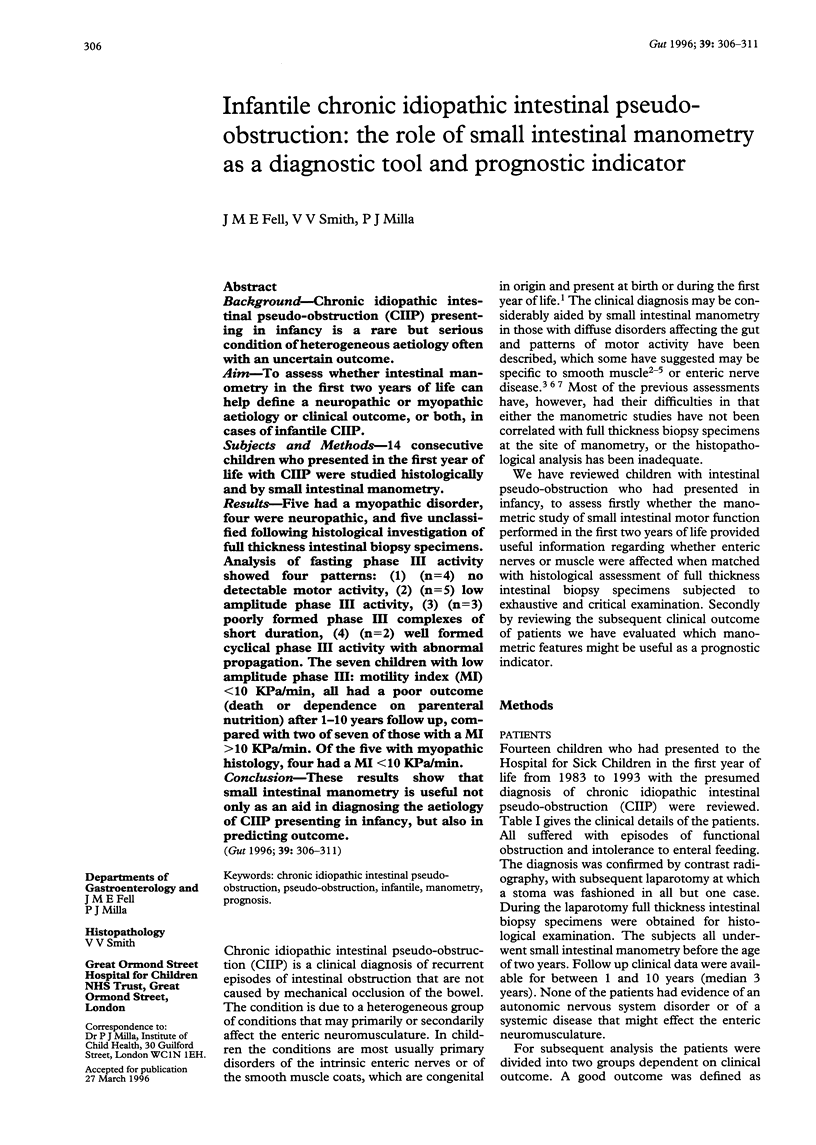
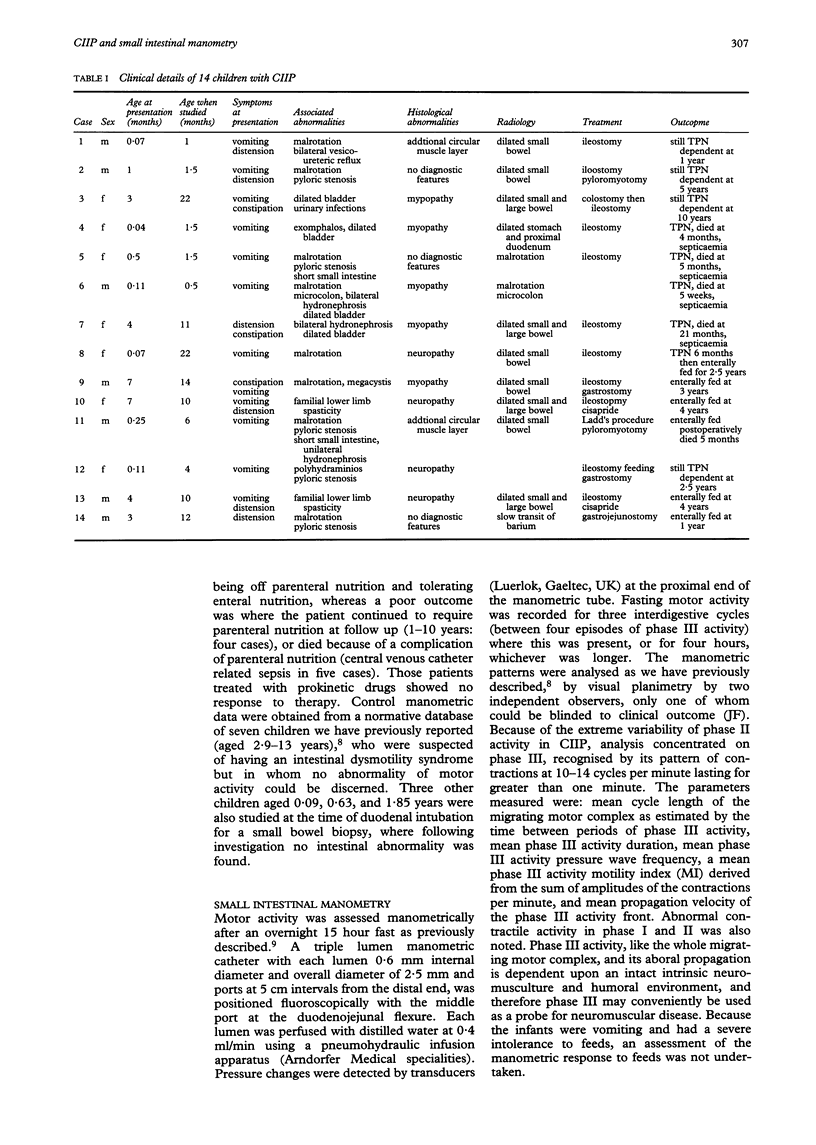
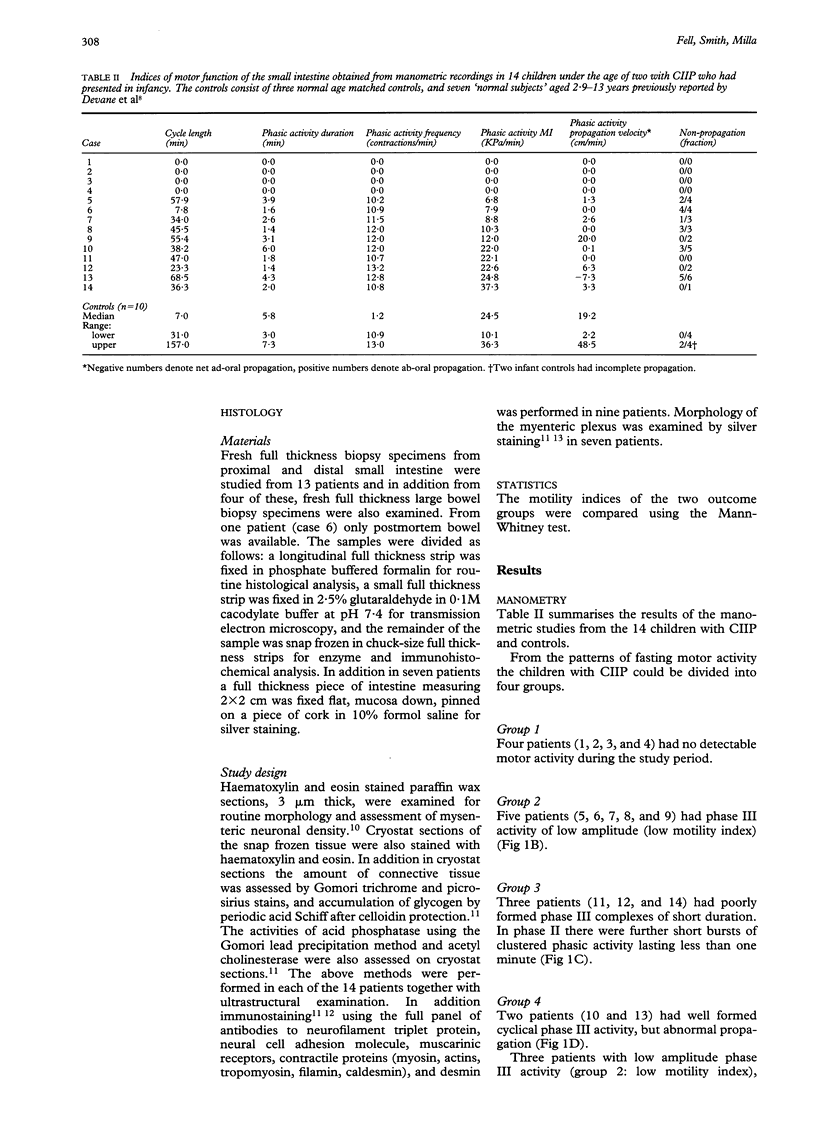
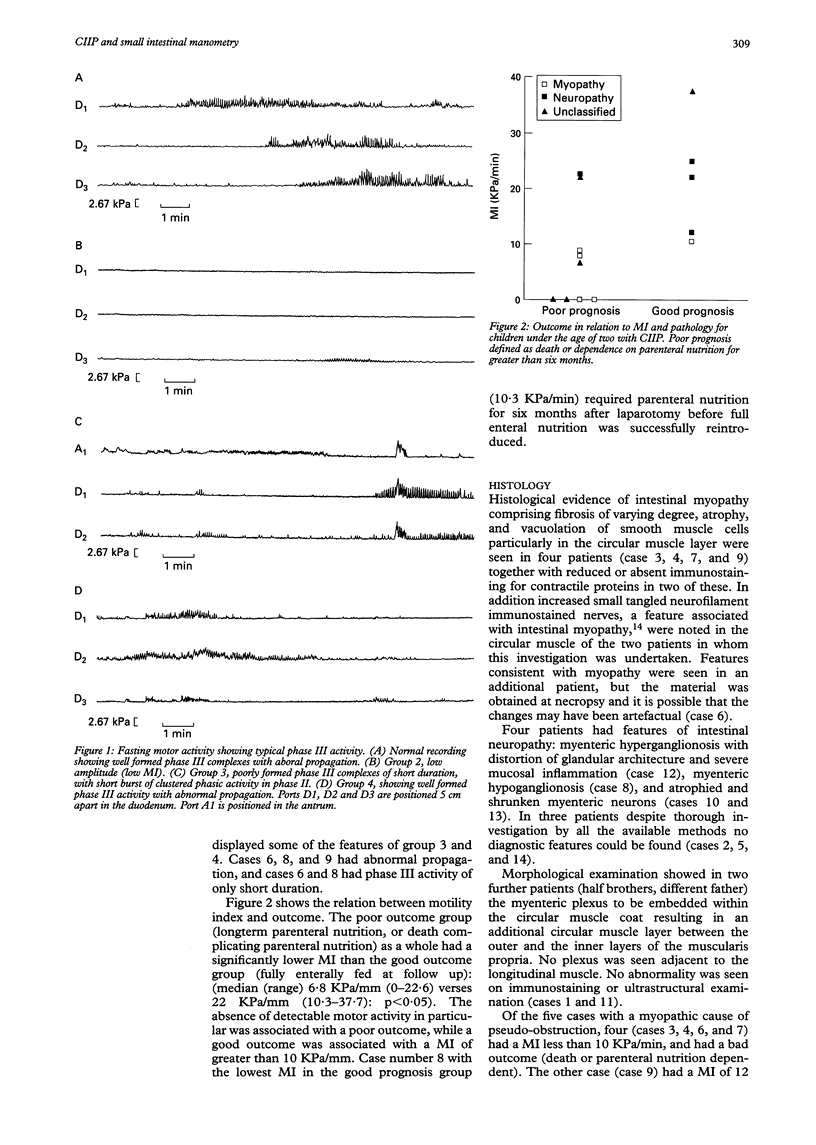
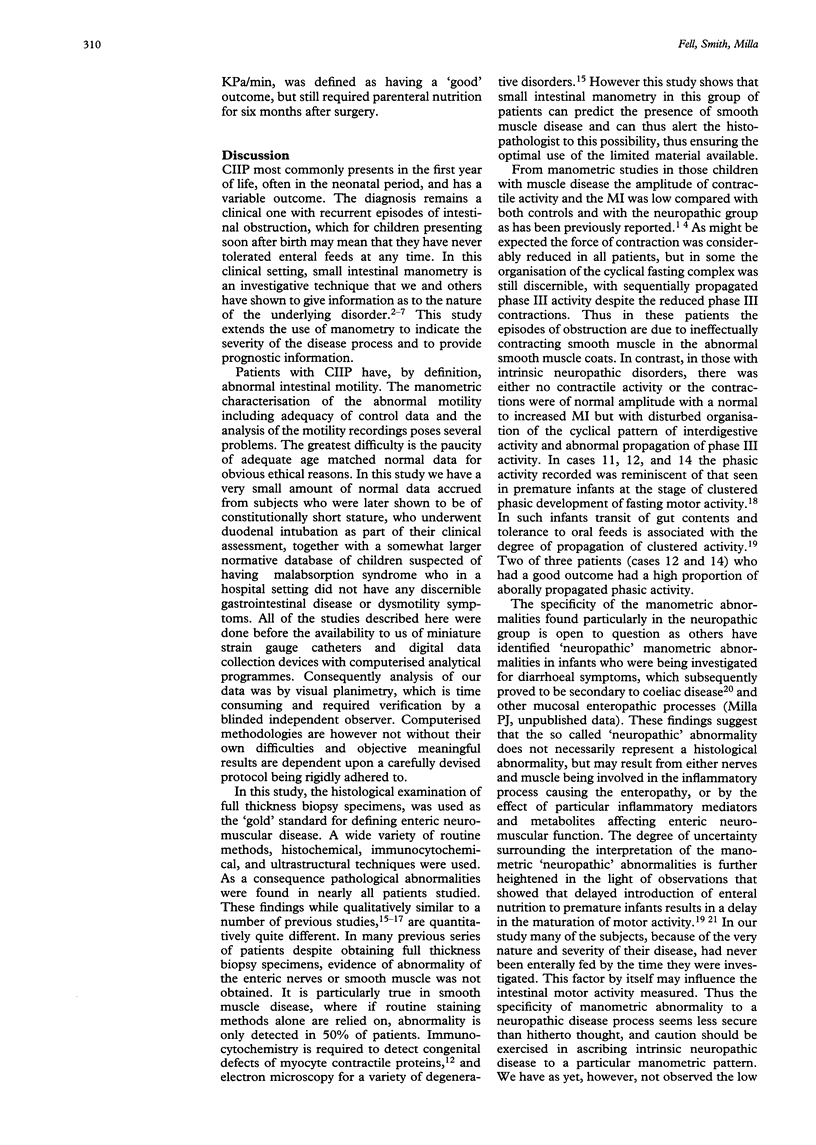
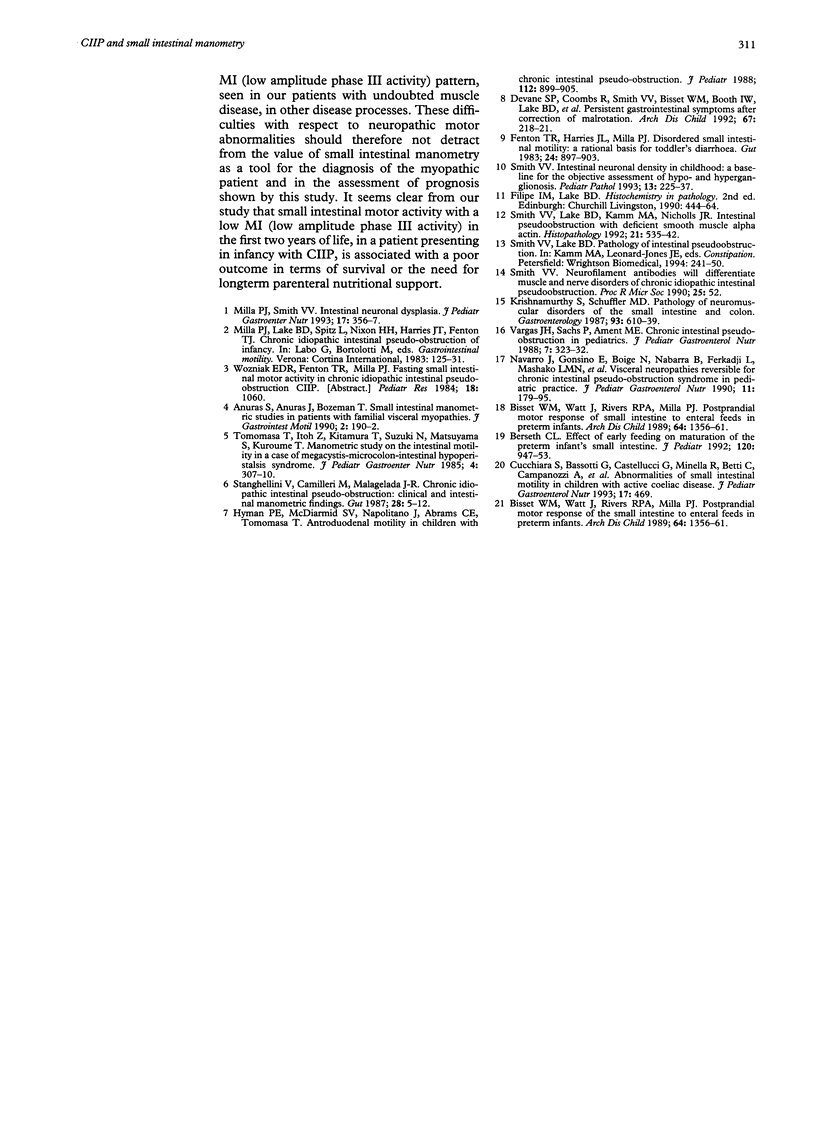
Selected References
These references are in PubMed. This may not be the complete list of references from this article.
- Berseth C. L. Effect of early feeding on maturation of the preterm infant's small intestine. J Pediatr. 1992 Jun;120(6):947–953. doi: 10.1016/s0022-3476(05)81969-9. [DOI] [PubMed] [Google Scholar]
- Bisset W. M., Watt J., Rivers R. P., Milla P. J. Postprandial motor response of the small intestine to enteral feeds in preterm infants. Arch Dis Child. 1989 Oct;64(10 Spec No):1356–1361. doi: 10.1136/adc.64.10_spec_no.1356. [DOI] [PMC free article] [PubMed] [Google Scholar]
- Bisset W. M., Watt J., Rivers R. P., Milla P. J. Postprandial motor response of the small intestine to enteral feeds in preterm infants. Arch Dis Child. 1989 Oct;64(10 Spec No):1356–1361. doi: 10.1136/adc.64.10_spec_no.1356. [DOI] [PMC free article] [PubMed] [Google Scholar]
- Devane S. P., Coombes R., Smith V. V., Bisset W. M., Booth I. W., Lake B. D., Milla P. J. Persistent gastrointestinal symptoms after correction of malrotation. Arch Dis Child. 1992 Feb;67(2):218–221. doi: 10.1136/adc.67.2.218. [DOI] [PMC free article] [PubMed] [Google Scholar]
- Fenton T. R., Harries J. T., Milla P. J. Disordered small intestinal motility: a rational basis for toddlers' diarrhoea. Gut. 1983 Oct;24(10):897–903. doi: 10.1136/gut.24.10.897. [DOI] [PMC free article] [PubMed] [Google Scholar]
- Hyman P. E., McDiarmid S. V., Napolitano J., Abrams C. E., Tomomasa T. Antroduodenal motility in children with chronic intestinal pseudo-obstruction. J Pediatr. 1988 Jun;112(6):899–905. doi: 10.1016/s0022-3476(88)80211-7. [DOI] [PubMed] [Google Scholar]
- Krishnamurthy S., Schuffler M. D. Pathology of neuromuscular disorders of the small intestine and colon. Gastroenterology. 1987 Sep;93(3):610–639. doi: 10.1016/0016-5085(87)90926-7. [DOI] [PubMed] [Google Scholar]
- Milla P. J., Smith V. V. Intestinal neuronal dysplasia. J Pediatr Gastroenterol Nutr. 1993 Nov;17(4):356–357. doi: 10.1097/00005176-199311000-00003. [DOI] [PubMed] [Google Scholar]
- Navarro J., Sonsino E., Boige N., Nabarra B., Ferkadji L., Mashako L. M., Cezard J. P. Visceral neuropathies responsible for chronic intestinal pseudo-obstruction syndrome in pediatric practice: analysis of 26 cases. J Pediatr Gastroenterol Nutr. 1990 Aug;11(2):179–195. doi: 10.1097/00005176-199008000-00006. [DOI] [PubMed] [Google Scholar]
- Smith V. V. Intestinal neuronal density in childhood: a baseline for the objective assessment of hypo- and hyperganglionosis. Pediatr Pathol. 1993 Mar-Apr;13(2):225–237. doi: 10.3109/15513819309048209. [DOI] [PubMed] [Google Scholar]
- Smith V. V., Lake B. D., Kamm M. A., Nicholls R. J. Intestinal pseudo-obstruction with deficient smooth muscle alpha-actin. Histopathology. 1992 Dec;21(6):535–542. doi: 10.1111/j.1365-2559.1992.tb00441.x. [DOI] [PubMed] [Google Scholar]
- Stanghellini V., Camilleri M., Malagelada J. R. Chronic idiopathic intestinal pseudo-obstruction: clinical and intestinal manometric findings. Gut. 1987 Jan;28(1):5–12. doi: 10.1136/gut.28.1.5. [DOI] [PMC free article] [PubMed] [Google Scholar]
- Tomomasa T., Itoh Z., Koizumi T., Kitamura T., Suzuki N., Matsuyama S., Kuroume T. Manometric study on the intestinal motility in a case of megacystis-microcolon-intestinal hypoperistalsis syndrome. J Pediatr Gastroenterol Nutr. 1985 Apr;4(2):307–310. doi: 10.1097/00005176-198504000-00027. [DOI] [PubMed] [Google Scholar]
- Vargas J. H., Sachs P., Ament M. E. Chronic intestinal pseudo-obstruction syndrome in pediatrics. Results of a national survey by members of the North American Society of Pediatric Gastroenterology and Nutrition. J Pediatr Gastroenterol Nutr. 1988 May-Jun;7(3):323–332. [PubMed] [Google Scholar]


